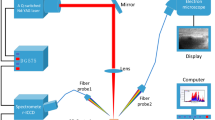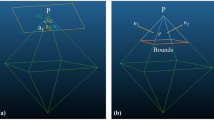Abstract
The capacity of additive manufacturing (AM) to create products with intricate characteristics has produced its rapid expansion in the manufacturing business and widespread interest from a wide range of other sectors. To ensure that parts made for functional use meet specified standards, especially in terms of quality and dependability, quality management of the AM components has drawn a lot of attention from the industries. Unnecessary porosities have a substantial impact on how well the products manufactured via AM operate mechanically. In order to continue to enhance the standard of the AM components by outlier detection, the quality control procedures are thus necessary. In order to efficiently identify outliers in AM data, this work introduces the binary-weighted sparrow search fine-tuned random forest (BSS-RF) method. The binary-weighted sparrow search optimization (BSSO) method is proposed to optimize the RF’s performance in order to increase the detection accuracy. To remove the noisy data, raw data samples are enhanced using the normalization procedure. The important features are extracted using quadratic discriminant analysis (QDA). Finally, the suggested strategy is used to identify abnormal occurrences. The efficacy of the suggested approach is supported by experimental data. The suggested approach can be used in various industrial sectors, including electrical engineering, mechanical engineering, and medical engineering. We intend to create an interactive outlier identification system that is based on the suggested technique for real-time outlier identification and fault forecasting in the future.









Similar content being viewed by others
Data availability
Not applicable.
Code availability
Not applicable.
References
Vishwakarma GK, Paul C, Elsawah AM (2020) An algorithm for outlier detection in a time series model using backpropagation neural network. J King Saud Univ-Sci 32(8):3328–3336
Jin Z, Zhang Z, Demir K, Gu GX (2020) Machine learning for advanced additive manufacturing. Matter 3(5):1541–1556
Zhao X, Rosen DW (2017) A data mining approach in real-time measurement for polymer additive manufacturing process with exposure controlled projection lithography. J Manuf Syst 43:271–286
Bartlett JL, Jarama A, Jones J, Li X (2020) Prediction of microstructural defects in additive manufacturing from powder bed quality using digital image correlation. Mater Sci Eng, A 794:140002
Bose S, Pal A, SahaRay R, Nayak J (2015) Generalized quadratic discriminant analysis. Pattern Recogn 48(8):2676–2684
Charalampous P, Kostavelis I, Kopsacheilis C, Tzovaras D (2021) Vision-based real-time monitoring of extrusion additive manufacturing processes for automatic manufacturing error detection. Int J Adv Manuf Technol 115:3859–3872
Li R, Jin M, Paquit VC (2021) Geometrical defect detection for additive manufacturing with machine learning models. Mater Des 206:109726
Gunasegaram DR, Murphy AB, Matthews MJ, DebRoy T (2021) The case for digital twins in metal additive manufacturing. J Phys Mater 4(4):040401
Liu C, Kong Z, Babu S, Joslin C, Ferguson J (2021) An integrated manifold learning approach for high-dimensional data feature extractions and its applications to online process monitoring of additive manufacturing. IISE Transactions 53(11):1215–1230
AbouelNour Y, Gupta N (2022) In-situ monitoring of sub-surface and internal defects in additive manufacturing: a review. Mater Des 111063
Bhatt PM, Kulkarni A, Kanyuck A, Malhan RK, Santos LS, Thakar S, Bruck HA, Gupta SK (2022) Automated process planning for conformal wire arc additive manufacturing. Int J Adv Manuf Technol 1–26
Mahmoud D, Magolon M, Boer J, Elbestawi MA, Mohammadi MG (2021) Applications of machine learning in process monitoring and controls of L-PBF additive manufacturing: a review. Appl Sci 11(24):11910
Qi X, Chen G, Li Y, Cheng X, Li C (2019) Applying neural-network-based machine learning to additive manufacturing: current applications, challenges, and future perspectives. Engineering 5(4):721–729
Superville C, Mehrez A, Shafti F, Harrast S, Hayes G, McGilsky DE, Samanta S, Neves J (2014) Outlier detection in autocorrelated manufacturing processes. Int J Qual Product Manag 11(1):1–11
Alhwarin F, Ferrein A, Gebhardt A, Kallweit S, Scholl I, Tedjasukmana O (2015). Improving additive manufacturing by image processing and robotic milling. In 2015 IEEE Int.
Rivet I, Dialami N, Cervera M, Chiumenti M, Valverde Q (2023) Mechanical analysis and optimized performance of G-Code driven material extrusion components. Addit Manuf 61:103348
Davis IVLA, Donnal JS, Kutzer MD (2020) November. Tracking additive manufacturing using machine vision. In 2020 IEEE 10th International Conference Nanomaterials: Applications & Properties (NAP) (pp. 02SAMA22–1). IEEE.
Afarani HT, Moser NH, Garboczi EJ, Esfahani EN, Biernacki JJ (2022) Print fidelity metrics for additive manufacturing of cement-based materials. Addit Manuf 55:102784
Mac G, Mandal M, Rastogi A, Gailani G, Pearce H, Gupta N (2022) Application of micro-computed tomography for authentication of 3D printed composite parts. Addit Manuf Lett 3:100104
Zhan Z, Li H (2021) Machine learning based fatigue life prediction with effects of additive manufacturing process parameters for printed SS 316L. Int J Fatigue 142:105941
Yarahmadi AM, Breuß M, Hartmann C (2022) September. Long short-term memory neural network for temperature prediction in laser powder bed additive manufacturing. In Intelligent Systems and Applications: Proceedings of the 2022 Intelligent Systems Conference (IntelliSys) Volume 3 (pp. 119–132). Cham: Springer International Publishing.
Shen W, Zhang X, Jiang X, Yeh LH, Zhang Z, Li Q, Li B, Qin H (2021) Surface extraction from micro-computed tomography data for additive manufacturing. Procedia Manuf 53:568–575
Zeiser A, Özcan B, Kracke C, van Stein B, Bäck T (2023) A data-centric approach to anomaly detection in layer-based additive manufacturing. at-Automatisierungstechnik, 71(1):81–89
Li W, Zhang H, Wang G, Xiong G, Zhao M, Li G, Li R (2023) Deep learning based online metallic surface defect detection method for wire and arc additive manufacturing. Robot Comput-Integr Manuf 80:102470
Lu L, Hou J, Yuan S, Yao X, Li Y, Zhu J (2023) Deep learning-assisted real-time defect detection and closed-loop adjustment for additive manufacturing of continuous fiber-reinforced polymer composites. Robot Comput-Integr Manuf 79:102431
Nguyen NV, Hum AJW, Do T, Tran T (2023) Semi-supervised machine learning of optical in-situ monitoring data for anomaly detection in laser powder bed fusion. Virtual Phys Prototyp 18(1):e2129396
Lyu J, Akhavan J, Manoochehri S (2022) Image-based dataset of artifact surfaces fabricated by additive manufacturing with applications in machine learning. Data Brief 41:107852
Shevchik SA, Kenel C, Leinenbach C, Wasmer K (2018) Acoustic emission for in situ quality monitoring in additive manufacturing using spectral convolutional neural networks. Addit Manuf 21:598–604
Wang C, Tan XP, Tor SB, Lim CS (2020) Machine learning in additive manufacturing: state-of-the-art and perspectives. Addit Manuf 36:101538
Li Z, Li J, Wang Y, Wang K (2019) A deep learning approach for anomaly detection based on SAE and LSTM in mechanical equipment. Int J Adv Manuf Technol 103:499–510
Author information
Authors and Affiliations
Corresponding author
Ethics declarations
Ethics approval
Not applicable.
Consent to participate
Not applicable.
Consent for publication
Not applicable.
Conflict of interest
The authors declare no competing interests.
Additional information
Publisher's Note
Springer Nature remains neutral with regard to jurisdictional claims in published maps and institutional affiliations.
Rights and permissions
Springer Nature or its licensor (e.g. a society or other partner) holds exclusive rights to this article under a publishing agreement with the author(s) or other rightsholder(s); author self-archiving of the accepted manuscript version of this article is solely governed by the terms of such publishing agreement and applicable law.
About this article
Cite this article
Dutta, C., Nagarajan, N., Adhoni, Z.A. et al. Outlier detection in additive manufacturing using novel machine learning algorithm. Int J Adv Manuf Technol (2023). https://doi.org/10.1007/s00170-023-12798-9
Received:
Accepted:
Published:
DOI: https://doi.org/10.1007/s00170-023-12798-9




